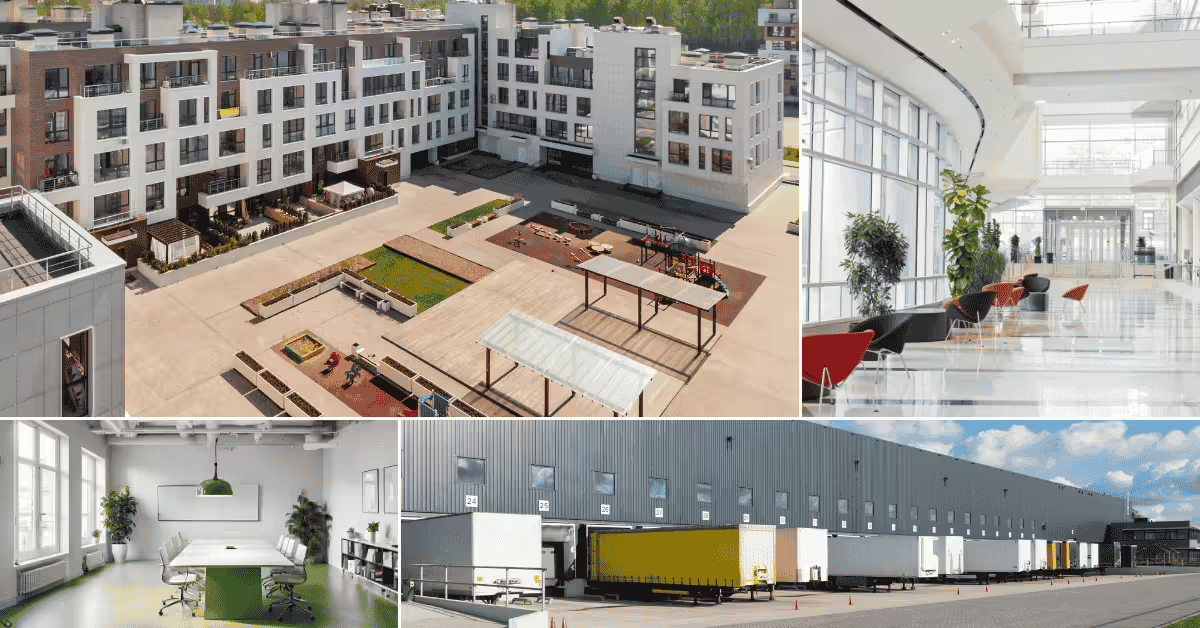Leasing commercial property? Don’t let simple mistakes cost you big. From hidden fees to overlooked clauses, this guide walks you through what to avoid and why it matters.

2025 Commercial Real Estate Trends: Predictions & Surprises Ahead
As we move toward 2025, the commercial real estate market is preparing for shifts driven by changes in technology, market dynamics, and tenant preferences. This is especially true in Alabama’s urban areas like Montgomery and Birmingham, where these trends are reshaping the real estate landscape.
Whether you’re an investor, developer, or business owner, staying ahead of these trends will help you make more informed and strategic decisions. Let’s explore the top commercial real estate trends expected to impact Alabama and beyond in 2025!
Sustainability Takes Center Stage
Sustainability has gone from being a bonus to becoming a necessity. As climate concerns increase, more businesses are seeking energy-efficient, eco-friendly spaces. In 2025, certifications like LEED and BREEAM will continue to signal environmental responsibility, drawing tenants focused on green practices.
For commercial real estate investors, sustainable properties may offer long-term value. Not only do they reduce operational costs through energy savings, but they also attract high-quality tenants, which can boost the property’s value over time.
- Will sustainability continue to be a priority in the future?
- Yes, as regulations become stricter and businesses focus more on environmental responsibility, the demand for sustainable properties is expected to grow.
- What are some examples of sustainability features in commercial real estate?
- Examples include energy-efficient HVAC systems, solar panels, water-saving fixtures, and smart building technologies that monitor and reduce energy use.
- Are sustainable properties more expensive to develop or buy?
- While the initial costs may be higher, the long-term savings from reduced energy usage and maintenance can offset these costs. Additionally, sustainable buildings often attract tenants willing to pay premium rents, which can increase your return on investment.
Rise of Hybrid Workspaces
As hybrid work models become more permanent, traditional office layouts are losing relevance. In 2025, businesses will prioritize properties that support flexible work environments, offering a blend of remote work capabilities and collaborative, adaptable spaces.
Properties that cater to this new way of working may hold great investment potential. Spaces with flexible layouts and coworking areas will attract companies seeking versatile office solutions.
- How does investing in hybrid workspaces differ from traditional office spaces?
- Traditional offices are designed for permanent, on-site staff and typically have fixed layouts. Hybrid workspaces need more flexibility and often feature shared amenities like coworking spaces and remote communication technology.
- Will hybrid workspaces require more investment in technology?
- Yes– technology is a key element in successful hybrid workspaces. High-speed internet, video conferencing systems, and smart building features (like automated lighting and temperature controls) will be essential for hybrid work environments.
- Is there a risk that hybrid workspaces will lose popularity in the future?
- While businesses may change how they operate over time, hybrid workspaces offer the flexibility that many companies in Alabama value, making them likely to remain relevant.
Health and Wellness Are Top Priorities
Health and wellness are becoming central to the commercial real estate market, especially in larger cities like Montgomery, Huntsville, and Birmingham. Businesses are looking for office spaces that promote employee well-being with features like natural light, outdoor areas, and wellness amenities.
For investors, properties with health and wellness features may have a competitive edge. Companies recognize that healthier work environments contribute to happier, more productive employees.
- What makes an office space “wellness-friendly”?
- A wellness-friendly space can include natural lighting, air purification systems, ergonomic furniture, outdoor areas, fitness rooms, and quiet spaces for relaxation.
- Could wellness features be a waste of money in certain Alabama markets?
- In some markets where cost-saving is prioritized, wellness features might not deliver the same returns. It’s important to assess tenant demand before making significant investments in wellness amenities.
- Can wellness features become a liability if not maintained properly?
- Yes, wellness features can become a liability if not properly maintained. For example, fitness centers need regular cleaning and upkeep, and poor air quality in spaces advertised as “enhanced” can lead to tenant dissatisfaction.
Technology-Driven Smart Buildings
Smart buildings equipped with IoT (Internet of Things) technology are becoming the new norm, particularly in tech-forward cities like Huntsville. These buildings automate systems like lighting, HVAC, and security, improving tenant comfort while reducing operational costs.
Investors who focus on smart buildings may benefit from lower operational costs and increased tenant demand. Tech-savvy companies and those prioritizing sustainability are especially drawn to these high-tech properties.
- What are the main benefits for tenants in smart buildings?
- Tenants enjoy better comfort, security, and energy efficiency. Automated systems optimize the indoor environment, while reducing utility costs and supporting sustainability goals.
- Are smart buildings more vulnerable to cyberattacks?
- Smart buildings do have greater exposure to cyberattacks due to their reliance on IoT devices. However, strong cybersecurity measures can minimize these risks.
- What happens if the technology in smart buildings becomes outdated?
- Technology evolves quickly, so investors need to choose scalable systems that can be upgraded. Outdated technology may require costly upgrades, but planning ahead can mitigate this risk.
Urban Redevelopment and Mixed-Use Projects
Urban redevelopment is revitalizing underused areas across Alabama, transforming them into vibrant mixed-use developments. These projects combine residential, commercial, and retail spaces, creating communities where people can live, work, and shop in one place.
Investors interested in urban redevelopment can help transform neighborhoods while attracting diverse tenants. These projects often lead to higher property values and support community growth.
- Are there any challenges with investing in urban redevelopment projects?
- Yes, challenges may include navigating zoning regulations, managing construction timelines, and securing community support. Working with local governments and residents can help overcome these obstacles.
- What kind of tenants are typically attracted to mixed-use developments?
- Mixed-use developments attract both residential and commercial tenants. Young professionals appreciate the convenience of living near work and amenities, while businesses benefit from the built-in foot traffic.
- Can urban redevelopment projects face resistance from local communities?
- Yes, some projects may encounter resistance from residents concerned about gentrification or changes to the character of their neighborhoods. Early engagement with the community is key to addressing these concerns.
E-Commerce and Logistics Drive Industrial Demand
With the ongoing rise of e-commerce, the demand for warehouse and logistics spaces, especially near urban hubs like Birmingham and Montgomery, will continue to grow in 2025. Properties that support “last-mile” delivery are essential as businesses expand their supply chain operations.
For investors, this sector offers potential growth opportunities as businesses increasingly prioritize fast, efficient delivery.
- Is this growth in demand for warehouse space expected to continue long term?
- Yes, as e-commerce continues to grow, the demand for logistics and warehouse spaces is likely to remain strong.
- Are there risks associated with investing in warehouse and logistics spaces?
- Advances in technology, like automation or drone deliveries, could change logistics needs. Additionally, economic downturns could impact demand, so investors should stay informed about industry trends.
- Are there hidden costs associated with maintaining large logistics centers?
- Costs such as maintaining loading docks, upgrading technology, and handling heavy vehicle traffic can add up. It’s important to budget for ongoing expenses, especially for properties serving major e-commerce companies.
Flexible Lease Terms Gain Popularity
Economic uncertainty often drives businesses to seek flexible lease options. In 2025, tenants will look for shorter leases and customizable spaces, allowing them to adapt quickly to changing market conditions.
For commercial property owners and investors in Alabama, offering flexible leases can attract a broader range of tenants, improving retention and allowing for more frequent rent adjustments based on market conditions.
- Are flexible lease terms riskier for property owners?
- Shorter lease terms can increase turnover risk, but they also allow for more frequent rent adjustments, which can be an advantage in fluctuating markets.
- What types of businesses are most interested in flexible leases?
- Startups, tech companies, and businesses in fast-moving industries often prefer flexible leases, as they provide the agility needed to scale up or down.
- Are flexible lease terms more common in certain types of properties?
- Flexible leases are common in coworking spaces and properties catering to startups or tech companies. However, demand is also increasing in other sectors like retail and industrial spaces.
At Moore Company Realty, we understand the evolving commercial real estate market. Whether you’re looking to invest, lease, or develop properties in Alabama and surrounding areas, our team is here to guide you every step of the way. Contact us today to learn how we can help you navigate these trends and achieve your goals in 2025.



